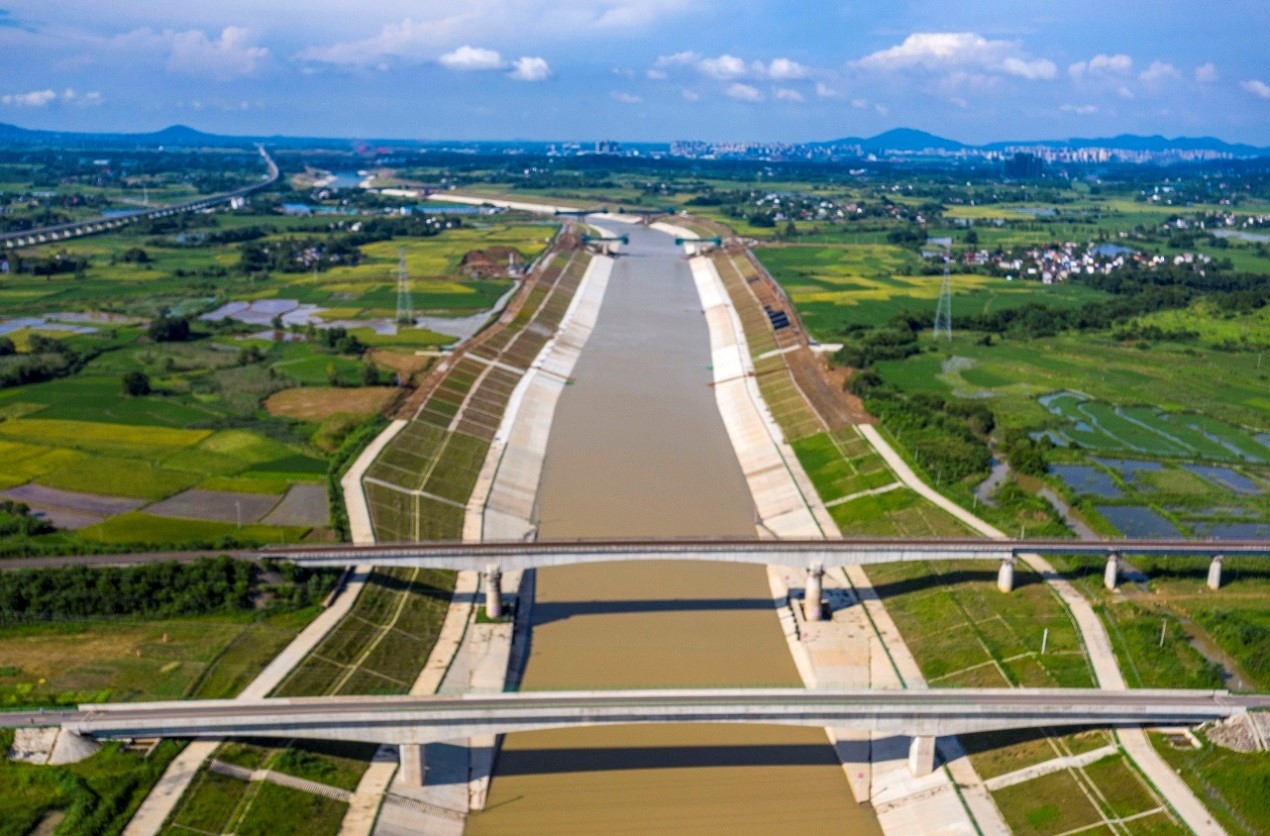China advances national water network projects to better benefit its people
The Huaihe River, between the Yellow River and the Yangtze River, is an important watercourse in central and east China. It is also the first major river that has been comprehensively treated since the founding of the People's Republic of China in 1949.

Photo shows the Qianping Reservoir in Ruyang county, Luoyang, central China's Henan province. The reservoir, as one of the 172 major water conservancy projects in China, has a storage capacity of 584 million cubic meters. (People's Daily Online/Kang Hongjun)
Recently, the second phase of an artificial outlet channel project for the Huaihe River commenced, which marked a new chapter in flood control of the river. The project comes with a total investment of 43.8 billion yuan ($6.48 billion), the highest for a single flood control project on the Huaihe River in the last 70 years.
The project is a miniature of China's national water network construction.
Since this year, a batch of major water conservancy projects has made remarkable progress and the construction of the water infrastructure network has been advanced. The national water network’s construction is also accelerating.
According to statistics released by the Ministry of Water Resources (MWR), China has invested 444.9 billion yuan in water conservancy development in the first half of 2022, up 59.5 percent year on year. A total of 14,000 water conservancy projects have commenced during this period, and 750 of them saw an investment of over 100 million yuan each.
A national water network that is complete, reliable, efficient, intelligent, and well-coordinated is taking shape.
An MWR official told People's Daily that China is promoting high-quality follow-up construction of the South-to-North Water Diversion Project and accelerating the implementation of major water diversion projects. The country is also working to build regional water resource allocation projects, tapping into the supply potential of existing water storage projects, and speeding up the construction of major water source projects, the official said.
The water resources in the Yangtze River basin and the region in the south of it account for 81 percent of the national total, while the region in the north of the river only has a share of 19 percent. Besides, around 60 to 70 percent of the precipitation in China is in the flood season which spans three to four months in the summer.

Photo taken in July 2021 shows a project diverting water from the Yangtze River to the Huaihe River in Ketan township, Lujiang county, Hefei, east China's Anhui province. (People's Daily Online/Zuo Xuechang)
To build the national water network is an inevitable mission for China to balance the uneven temporal and spatial distribution of water resources, said Qiao Jianhua, an MWR official.
The Chol River and the Xiliao River run parallel to each other like two jade belts in north China's Inner Mongolia autonomous region.
On the Chol River, a 48-meter-high dam is being built, which will be a major reservoir for a project diverting water from the Chol River to the Xiliao River, which spans a total of over 390 kilometers with water pipes, tunnels, culverts and inverted siphons.
Upon completion, the project will divert 454 million cubic meters of water on an annual basis and supply nine banners, cities and districts, as well as 11 industrial parks, said Xi Lin, general manager of Inner Mongolia Water Industry Investment Group.
In Nanmu township, Guiping of south China's Guangxi Zhuang autonomous region, the construction of the Datengxia water conservancy project is well underway. The project is designed to cover an irrigation area of over one million mu and will divert water to grain and sugar production bases in Guizhong from the Xijiang River, a main stream of the Pearl River in southern China.
These hydraulic projects are expected to play an important role in water supply, irrigation, flood control and ecological restoration through the science-based allocation of water resources.
The major projects of the national water network will be built with biological security and sustainability in mind, Qiao said.

Photo taken in May 2022 shows a irrigation cannel running through the farmland in Sanxigou village, Jundian township, Fangxian county, Shiyan, central China's Hubei province. The cannel is connected to a local reservoir. In the recent years, the county has built a modern water network with water diversion, cannel expansion and water storage projects. (People's Daily Online/Zhang Qilong)
Taking the second phase of the artificial outlet channel project for the Huaihe River as an example, Qiao introduced that relevant departments and organizations had conducted full discussion on flood analysis, as well as the scale and design of the project before it kicked off. Since 2012, the feasibility report of the project had gone through four rounds of assessment and multiple revisions, Qiao told People's Daily.
Ecology is taken as a priority in the construction of major water conservancy projects in China. At the Datengxia water conservancy project, fish steps that mimic natural river courses are built to facilitate fishes' migration, and during the construction of a project that diverts water from the Yangtze River to the Hanjiang River, a tributary of the Yangtze, relevant departments completed environmental monitoring, ecological investigation and in-situ surveys at 240 water sections over 20 times.
Major projects of the national water network, which feature long industrial chains, draw huge amounts of investment and powerfully drive employment, play a vital role in stabilizing the fundamentals of the macro economy. In the January-June period this year, the construction of water conservancy projects created 1.3 million jobs, offering firm support for stabilizing growth and employment.
Photos
Related Stories
- Annual sand-washing operation starts on Yellow River
- Water level on Minjiang River continues to rise
- Buffalo herd swims across Jialing River to forage in Sichuan
- New birth of Hainan's "mother river"
- In pics: flowing ice on Yellow River in Inner Mongolia
- China to severely punish environmental law violations in key river basins
- Nanning in S China’s Guangxi monitors water quality of rivers with 5G technology
- Scenery of Morigele River in Hulun Buir, N China
- Multiple measures improve bodies of water in China’s rural areas
- China’s ‘river chief’ system improves water quality
Copyright © 2022 People's Daily Online. All Rights Reserved.









